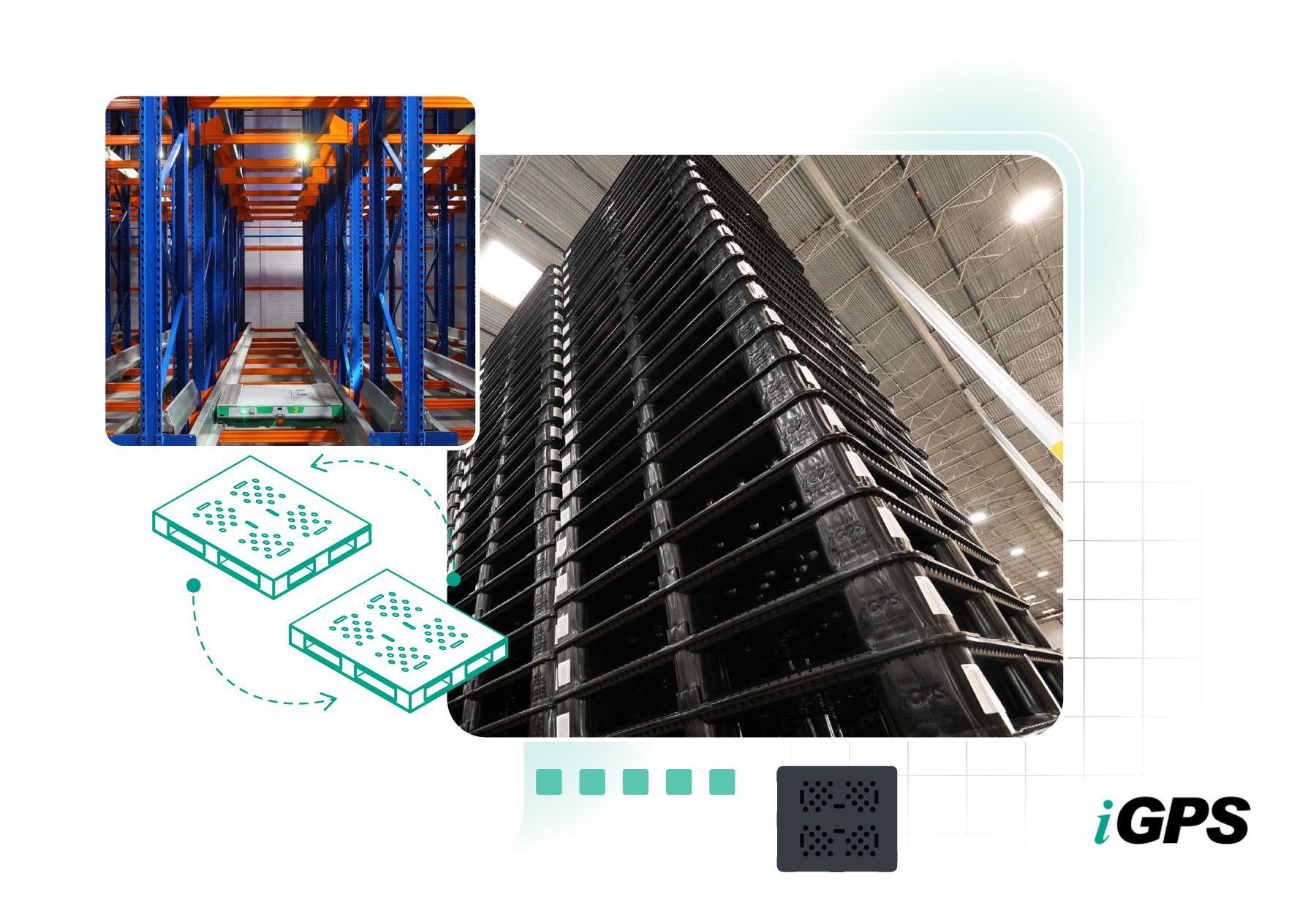Key takeaways
- Pallet storage systems help warehouses use space efficiently, improve access, and support automation.
- Storage formats—such as selective racks, drive-in lanes, push-back, pallet flow, AS/RS, or block stacking—offer different advantages for speed, density, and product access.
- Storage problems often stem from damaged pallets, inconsistent sizing, or poor organization, which reduce safety and slow operations.
- Plastic pallets support smoother storage performance because they offer consistent dimensions, strength, and better hygiene than many common wood options.
- Managed plastic pallet systems reduce maintenance work, improve warehouse cleanliness, and support safer, more efficient, and more predictable operations.
What Is a Pallet Storage System
A pallet storage system is the setup a warehouse uses to organize, hold, and retrieve palletized goods. It helps facilities use space efficiently, keep products accessible, and support smooth movement through manual or automated handling.
These systems may include static racks, drive-in lanes, pallet flow lanes, or automated retrieval equipment. Each option balances capacity, access, and speed. A well-planned system supports safe handling, clearer inventory control, and more predictable operations across the warehouse.
Types of Pallet Storage Systems
Warehouses use several storage formats to manage palletized goods. Each option supports different needs for speed, density, and access.
- Selective racking – Provides direct access to every pallet. Works well for broad product mixes or fast-moving inventory.
- Drive-in and drive-through racks – Increase storage density by allowing forklifts to enter the lane. Useful for large runs of the same SKU.
- Push-back racking – Uses carts on rails so multiple pallets can sit in each lane. Pallets are always loaded from the front, which saves time and space.
- Pallet flow (gravity flow) – Rollers move pallets from the loading side to the picking side, supporting first-in, first-out rotation.
- Automated storage and retrieval systems (AS/RS) – Robotic cranes or shuttles place and retrieve pallets with precision. These systems support higher throughput, stable product handling, and real-time data reporting.
- Block stacking – Pallets are stacked directly on the floor. This simple method works for sturdy goods that can handle deep stacking but limit individual access.
Each system has strengths based on inventory type, handling equipment, and the level of automation in the facility. Selecting the best option for your warehouse depends on inventory type, handling equipment, and operational goals.
Common Pallet Storage Challenges
Pallet storage systems face several common issues that slow handling, reduce accuracy, and add safety risks. Most problems stem from layout limitations, inconsistent pallets, or poor organization. Key challenges include:
- Space constraints: Tight aisles, crowded staging areas, or inefficient layouts reduce capacity and slow forklift movement. Industry data shows warehouse capacity use now averages about 86%. At that level, even small layout issues slow movement and reduce usable space.
- Mixed pallet quality: Variations in pallet condition create unstable loads. Broken boards or inconsistent sizing increase handling risks and disrupt storage flow.
- Irregular pallet dimensions: Pallets that don’t meet consistent sizing standards can jam racks, conveyors, or automated equipment. Even small variations cause delays.
- Product damage or contamination: Some pallet materials shed debris, absorb moisture, or carry contaminants that compromise product integrity—especially in food or pharma storage.
- Poor organization and labeling: Weak location tracking or unclear rack labels lead to misplacements, lost inventory, and longer retrieval times.
How Pallet Design Impacts Storage Systems
Pallet design shapes how well a storage system performs, especially as automation expands across the industry. The warehouse automation market is projected to reach nearly $30 billion in 2025 and grow to more than $63 billion by 2030, which means facilities depend more than ever on pallets that behave the same way every time.
Consistent sizing keeps pallets moving smoothly through racks, flow lanes, conveyors, and automated retrieval systems. Even small variations can slow robots, confuse scanners, or trigger conveyor stoppages. Lighter, stable platforms also reduce equipment strain and help maintain steady handling speeds.
Plastic pallets support these demands better than wood. Their uniform dimensions, smooth surfaces, and non-porous construction help protect products and equipment. They resist moisture, avoid splintering, and hold their shape in environments where automation needs predictable movement.
Strong, standardized pallet design keeps storage operations steady, efficient, and ready to scale—supporting higher throughput, safer handling, and reliable performance across both manual and automated systems.
The Advantage of Plastic Pallet Pooling
Plastic pallet pooling strengthens warehouse storage by keeping a steady supply of clean, consistent pallets in circulation. The pooling provider manages distribution, retrieval, repairs, and cleaning, which removes the need to store or maintain large stacks of empty pallets on-site.
Pallets in a pool follow the same design standards for size, weight, and strength, helping storage systems run without unexpected jams or alignment issues. Their non-porous surfaces resist moisture and debris, keeping facilities cleaner and supporting safer handling.
Embedded RFID tags work with scanning systems to record pallet movement at key points. This creates dependable usage and location data, improving accuracy for inventory checks and supporting better control across storage operations.
Pooling also helps reclaim floor space, lower maintenance efforts, and support long-term sustainability goals by keeping durable pallets in continuous rotation instead of discarding damaged wood units. The result is a storage system that’s cleaner, more efficient, and better aligned with modern automation and sustainability goals.
Conclusion
A well-designed pallet storage system helps warehouses move goods safely and predictably. It supports fast retrieval, steady throughput, and reliable quality control. The type of pallet used in that system shapes how well every component performs.
Plastic pallets bring consistency that racks, conveyors, and automated systems rely on. Their uniform size, smooth surfaces, and durable construction reduce equipment strain and help maintain clean, stable handling across each stage of storage. When supported by a managed pallet program, they stay in circulation longer and deliver dependable performance with less on-site upkeep.
Warehouses that upgrade their pallet approach gain smoother operations, clearer inventory control, and a more efficient storage environment overall.
FAQ
How do you maintain warehouse storage and racking systems?
Maintaining warehouse storage and racking systems requires regular attention and consistent routines:
- Inspect regularly – Look for bent beams, loose bolts, or corrosion. Address issues immediately to prevent collapse or injury.
- Keep areas clean – Remove debris and clutter to maintain clear aisles and proper pallet alignment.
- Use compatible pallets – Choose consistent, durable materials like plastic to prevent rack damage and ensure stability.
- Train your team – Review stacking limits, forklift safety, and proper loading procedures.
- Label and organize – Mark racks clearly to avoid confusion and handling errors.
- Schedule maintenance checks – Conduct periodic professional inspections to extend system life and keep operations safe.
How Often Should Warehouse Storage Systems Be Inspected?
Warehouse storage systems should be inspected at least once a year by a qualified professional, with visual checks done weekly or monthly by in-house staff. High-traffic or heavy-load areas may need more frequent reviews. Look for bent beams, rust, loose bolts, or damaged pallets that could compromise safety. Document every inspection and repair to maintain compliance and accountability. Train employees to report damage immediately, preventing small issues from becoming costly hazards. Regular inspections not only protect workers and inventory but also extend the life of racking systems and keep operations running efficiently and safely.
How can pallet pooling improve warehouse storage efficiency?
Pooling ensures a steady supply of high-quality, standardized pallets without the need for on-site inventory management or repairs. By using a shared network, companies can optimize space utilization, reduce downtime, and focus resources on core operations rather than pallet maintenance.
Can pallet storage systems integrate with warehouse automation?
Yes. Modern pallet storage systems are often designed to work seamlessly with automated guided vehicles (AGVs), conveyors, and robotic picking solutions. Plastic pallets with consistent specifications are ideal for these technologies, ensuring smooth system performance and fewer disruptions.
Companies optimizing warehouse performance and storage efficiency rely on durable, automation-ready iGPS plastic pallets. Their consistent sizing, lightweight design, and RFID compatibility improve accuracy, safety, and data visibility across every storage system. For more information, call 1-866-557-0184, email a specialist at switch@igps.net, or visit our contact page to learn how iGPS can enhance your warehouse operations.


